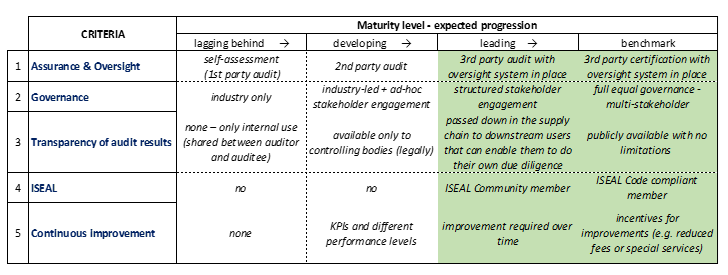The Automotive industry’s main actors (OEMs) are cognizant and at the same time concerned about various environmental and social risks taking place in raw materials upstream value chains covering such stages as extraction, production and processing with the associated impacts entering and occurring in the automotive supply chain. One of the main reasons for focusing Drive Sustainability efforts on a range of standards’ criteria is to encourage upstream actors and suppliers for the sustainable operational practices mitigating ESG and human rights/social risks, fostering continuous improvement and enhanced transparency across the value chains.
Responsible raw materials production and processing along with the subsequent sustainable sourcing are fundamental to Drive Sustainability, representing an essential part of the Drive Sustainability strategy devoted to Sustainable Supply/Value Chains. Given the existing abundance of standards present across industries and markets, standardization, and alignment on the common standards implementation approach within the industry are crucial for the future success of the efforts towards 100% sustainable automotive value chains. Whereas the standards are used by the multiple actors of the value chains for various purposes, it is important for all relevant actors to have a coordinated approach that will only reduce a burden on suppliers, increase coherence and ultimately enhance the impact of standards usage.
Criteria and their definitions
First of all, the message we would like to pass, and which should come as the connotation when there is any reference to the Drive Sustainability taking place, is that the way to the implementation of responsible raw materials sourcing is a journey. It is understandable to a certain extent that some supply chain actors are not completely there yet, so our expectation towards standards is to encourage their continuous improvement.
More importantly, we would like to share the commitment that, in parallel with striving for excellence and all the related efforts with regards to Sustainable sourcing, Drive Sustainability members are strongly encouraging all standard-setting initiatives to meet the proposed criteria, and as a consequence – to adapt their criteria actively if they don’t yet meet our requirements, whereas Drive Sustainability will ensure that the common standards recognition framework and its criteria are being regularly reviewed and updated whenever necessary. In the meantime, supporting this endeavour, Drive Sustainability members will strive for prioritizing acceptance of the standards that meet the defined criteria in their sourcing processes.
The main idea of the common standards recognition lies within the common voice within Drive Sustainability. Our ambition is to send a coherent and unified message to our suppliers and stakeholders, to promote standardization, common and/or similar approaches throughout the value chain. In addition, Drive Sustainability strives for the 3rd party verifications at mine site level.
Prior to coming to the definitions of each criterion, it is significant to mention that there are five key criteria around which the common standards approach was built: 1) assurance and oversight; 2) governance; 3) transparency of audit/certification results; 4) ISEAL* membership; and 5) continuous improvement. In the table below you can see Drive Sustainability’s expected progression for the standards, namely being left to right progression (focusing on the far right side of the table as an end-game scenario where all applicable standards should strive to be). Hereby Drive Sustainability acknowledges that the list of criteria could be reviewed thus open to inclusion of the new criteria and/or modification of the existing criteria in the future to make sure it properly reflects the strategy and the most recent developments in Sustainable sourcing practices of the automotive industry.
* – ISEAL (International Social and Environmental Accreditation and Labelling Alliance) – the global membership organization for ambitious, collaborative and transparent sustainability systems
DS Common Standards Recognition Framework

Criteria definitions
1. Assurance and Oversight
The first criteria refer to the assurance model adopted by a standard, which is used to determine whether a company is compliant with the requirements of a given standard. For any standard that lacks an assurance methodology/system, the expected progression is that it would start first to request a performed self-assessment, evolving to audits, and moving on to a third-party certification – being the latter considered as the most reliable verification system in terms of assurance of standards. To make sure all present assurance mechanisms which any standard claims to have in place are being duly respected and followed in practice, where assurance mechanisms are not defined unambiguously enough and allow more than one different interpretation or established through non-binding guidance only, the respective program/standard cannot be recognized in adherence to this criterion. The non-binding nature of guidance makes it from quite difficult to impossible to claim that the standard can deliver a certain performance level across all participating entities. The risk that comes with this uncertainty means that recognition cannot be granted.
As for oversight, its main purpose is to ensure that assurance providers and auditors are indeed fit to do their job (reflected in respective qualifications, experience, trainings, etc.) and deliver it well and, equally important, in an impartial way i.e. being fully independent and having no conflicts of interest. Both assurance and oversight are important quality control functions, which is why they both contribute to the recognition framework as one of the criteria.
2. Governance
Governance refers to the stakeholders involved in the standard, particularly in its board and decision-making process. We expect that industry-only standards will evolve to include stakeholders from different segments in their governing bodies, e.g. civil society is especially important here. In their journey to get there, having ad hoc engagement with other stakeholders may be the first important step in the expected progression, which should also evolve further to structured stakeholder engagement, and then advancing up to incorporation of full equal governance among the different stakeholders comprising the board. Interested stakeholders should have appropriate opportunities to participate in and provide input to the process.
3. Transparency of audit/certification results
It is important to mention that accessibility and transparency (way of communication) of audit results play a crucial role in building trust and credibility around any standard. It doesn’t only allow to reach any visible and sometimes very significant improvements of performance as result of the follow-up actions performed by the auditee, but also pinpoints relevant gaps to the stakeholders and might serve for a learning exchange within interested stakeholder communities e.g. enabling them to do their own due diligence. Transparency also relates to the extent of publicly available information about the performance of the entities being audited/certified.
4. ISEAL membership
Being ISEAL member means to be a member of the global membership association for sustainability standards, and our ambition is that all initiatives would comply with their standards and finally become their member – at first an ISEAL Community Member, and then progressing to ISEAL Code Compliant Member.
ISEAL Community Member category is open to sustainability systems that demonstrate transparency and continuous improvement. Community Members share experiences and learnings to build a community of trust and collaboration.
Certification as ISEAL Code Compliant Member is possible to be achieved only after 12 months of being recognized as the member who has been in good standing as ISEAL Community Member and meaning that the standard/sustainability system is compliant with all three ISEAL Codes of Good Practice** by meeting independent evaluation requirements.
5. Continuous improvement
It is crucial for sustainable results delivery and long-term success that standards have ambitious requirements that in turn stimulate the continuous improvement within the companies that follow and strive to meet them. Therefore, the first step for the standards which have not incorporated this important element yet would be to introduce measurable and assessable KPIs and different performance levels. Apart from that each recognized standard itself should be periodically reviewed and revised as best practices evolve as well as new regulations come into force and new risks occur.
From there, our expectation is that standards develop a framework for improvements to be met over a certain timeframe meaning that meeting a standard/getting a certification is not a one-off exercise, but it implies a certain commitment to improve further. Finally, it is also expected that standards would provide incentives for such improvements, which could be represented by reduced fees and/or special services within their members’ communities.
** – ISEAL Assurance Code of Good Practice, ISEAL Impacts Code of Good Practice, ISEAL Standard-Setting Code of Good Practice

